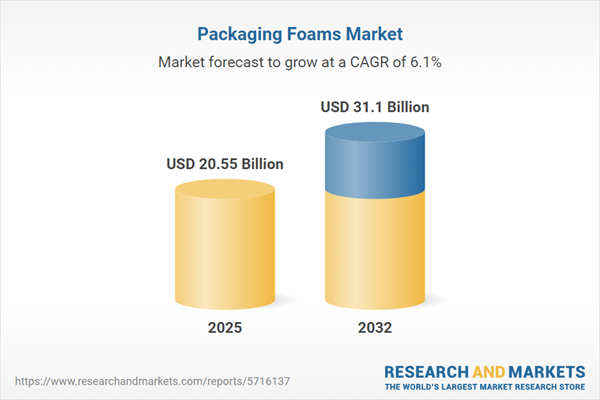Speak directly to the analyst to clarify any post sales queries you may have.
Senior executives in the packaging foams market are navigating a transformative landscape where regulatory shifts, evolving supply chain models, and stakeholder demands require a careful balance of innovation and compliance. Effectively managing these dynamics enables organizations to protect market share, meet stakeholder expectations, and ensure operational continuity in global markets.
Market Snapshot: Packaging Foams Market Overview
The packaging foams market is experiencing marked growth, supported by advancements in polymer technology and the expansion of e-commerce channels. Heightened regulatory requirements and the pressing need for risk mitigation continue to influence market dynamics, driving organizations to enhance supply strategies and compliance frameworks. Increased operational agility and the integration of innovative solutions remain key for organizations seeking to create strategic value in environments shaped by new policy standards. Senior leaders are prioritizing adaptive and resilient infrastructures to address rising global expectations and rapidly changing regulatory landscapes.
Scope & Segmentation of the Packaging Foams Market
A well-defined segmentation enables organizations to align investment, procurement, and compliance strategies with evolving market needs. Each segment reflects a core intersection between operational strategy and regional or sectoral demands:
- Foam Type: Flexible foams adapt to diverse packaging requirements, while rigid foams are essential for safeguarding sensitive or high-value items.
- Material Type: Selecting between bio-based polymers, polyethylene, and polyurethane helps organizations address compliance, sustainability, and lifecycle performance goals.
- Form: Options such as blocks, pouches, sheets, wrap rolls, tubing, and liners offer logistical flexibility and support tailored fulfillment needs.
- Thickness Category: Variations—from under 2 mm to over 5 mm—enable compliance with sector-specific standards and safety requirements.
- Distribution Channel: Both traditional and digital procurement support ongoing supply chain stability across different business operations.
- Application: Packaging foams are integral for insulation, product cushioning, and protecting surfaces in sectors ranging from electronics to food processing and manufacturing.
- End-User: Industries such as automotive, construction, healthcare, retail, and defense implement foam packaging to support stringent compliance and streamline logistics.
- Regions: Adapted strategies respond to regional compliance drivers and consumer behaviors throughout the Americas, Europe, Middle East, Africa, and Asia-Pacific, strengthening both global and localized sourcing initiatives.
Key market players, including Berry Global Inc., Covestro AG, Arkema Group, BASF SE, LG Chem Ltd., and The Dow Chemical Company, influence industry evolution by developing innovative materials and solidifying compliance protocols across each segment to drive technology adoption and efficiency improvements.
Key Takeaways for Senior Decision-Makers
- Leveraging advanced polymer solutions and procurement technology allows organizations to meet shifting regulatory expectations and maintain competitive parity.
- Pursuing sustainability through closed-loop systems and improved recycling builds transparency and enhances sourcing reliability as markets evolve.
- Regional supplier partnerships improve responsiveness to local environmental and legal requirements, supporting stable procurement processes.
- Designing modular packaging attuned to e-commerce enables adaptation to volume fluctuation and secure transit protection.
- Expanding manufacturing capabilities into multiple geographies increases resilience to regulatory changes and supports supply chain flexibility.
- Diversifying supplier networks ensures operational agility in reaction to changing global trade and compliance conditions.
Tariff Impact and Supply Chain Adaptation
Ongoing U.S. tariffs have elevated input costs for packaging foam manufacturers, leading to increased margin pressures and prompting a re-evaluation of sourcing strategies. Organizations are diversifying procurement to capitalize on regions with favorable tariff conditions and are scaling domestic investments. These adjustments contribute to more reliable supply chains in today’s variable global trading context.
Methodology & Data Sources in the Packaging Foams Market
This analysis is built on a rigorous methodology that integrates executive-level interviews, proprietary analytics, regulatory reviews, and insights from expert panels. The approach ensures that insights remain relevant, practical, and aligned with the specific priorities of senior leaders overseeing procurement and supply chain functions.
Why This Report Matters for Packaging Foams Market Stakeholders
- Procurement and supply chain leaders are equipped to evolve compliance and sourcing strategies proactively in response to market and regulatory changes.
- Organizations can recognize growth opportunities by adopting flexible supplier management approaches and robust risk mitigation—even during market volatility.
- The report offers actionable guidance to drive cross-regional process optimization and sustainable performance enhancements.
Conclusion
Applying these insights—tailored to the packaging foams market—enables senior executives to strengthen organizational agility, reinforce sustainability objectives, and sustain high-performing strategies amid ongoing global transformation.
Additional Product Information:
- Purchase of this report includes 1 year online access with quarterly updates.
- This report can be updated on request. Please contact our Customer Experience team using the Ask a Question widget on our website.
Table of Contents
3. Executive Summary
4. Market Overview
7. Cumulative Impact of Artificial Intelligence 2025
Companies Mentioned
The companies profiled in this Packaging Foams market report include:- Berry Global Inc.
- Covestro AG
- Arkema Group
- Armacell International S.A.
- Asahi Kasei Corporation
- BASF SE
- Borealis AG
- Carpenter Co.
- Cruz Foam
- Evonik Industries AG
- Foam Packaging, Inc.
- Furukawa Electric Co., Ltd.
- Huntsman International LLC
- JSP Corporation
- Kaneka Corporation
- LG Chem Ltd.
- Mitsui Chemicals America, Inc.
- Pregis LLC
- Protective Packaging Inc.
- Rogers Corporation
- Sealed Air Corporation
- Storopack Hans Reichenecker GmbH
- Sumitomo Chemical Co., Ltd.
- The Dow Chemical Company
- UFP Technologies, Inc.
- Zotefoams PLC.
Table Information
| Report Attribute | Details |
|---|---|
| No. of Pages | 199 |
| Published | November 2025 |
| Forecast Period | 2025 - 2032 |
| Estimated Market Value ( USD | $ 20.55 Billion |
| Forecasted Market Value ( USD | $ 31.1 Billion |
| Compound Annual Growth Rate | 6.0% |
| Regions Covered | Global |
| No. of Companies Mentioned | 27 |









